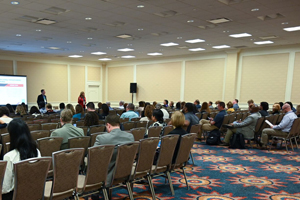
by Christine Kerlin, Senior Consultant, AACRAO
Dr. Randy Weber, Vice President, Student Success and Engagement, Johnson County Community College and Dr. Karen Miller, Provost, Cuyahoga Community College provided several examples of policies and processes that may be barriers to student success, both
for students and the institution.
Sharing their institutional experiences, they described a problematic process or policy identified on their campus, and then outlined how it was revised. (Examples include as Holds processes, documentation for residency, drops for non-payment, prior learning
guidelines, registering transient students, course repeat requirements, and more.) In some cases, a gap in service was identified and resolved through development of a new service.
9 key questions
Though all campuses have different challenges, these questions can help identify where and how to start addressing barriers on your campus:
- What are you embarrassed to tell students that they have to do? Ask front-line staff; they have powerful insight. Most institutions quite likely have some “shovel ready” opportunities to improve their services.
- Why are we doing it this way, and is it this good for students?
- Who can we work with? Efforts to reduce barriers by revising policies and processes usually require collaboration among several units and divisions, and may take some negotiation. This collaboration can result not only in improved service,
but also stronger relationships.
- How does our technology supports process improvements?
- Do our resources reflect our student success goals?
- Do your policies adversely affect special populations? Look at your Equity agenda.
- How do these changes affect gatekeepers? Sometimes change has deeper implications.
- Who are our peers and what are they doing? Developing a list of peer institutions and comparing your processes and policies with theirs can be a helpful way to evaluate possible avenues for improvement.
Removing policy barriers students meant students experienced less runaround, faster turnaround, and less frustration. Institutions benefited from more efficiency, fewer lines, and, in some cases, enrollment gains.
Process improvements may be part of a SEM plan, or perhaps simply be low-hanging fruit that is just waiting for us to work on right now.